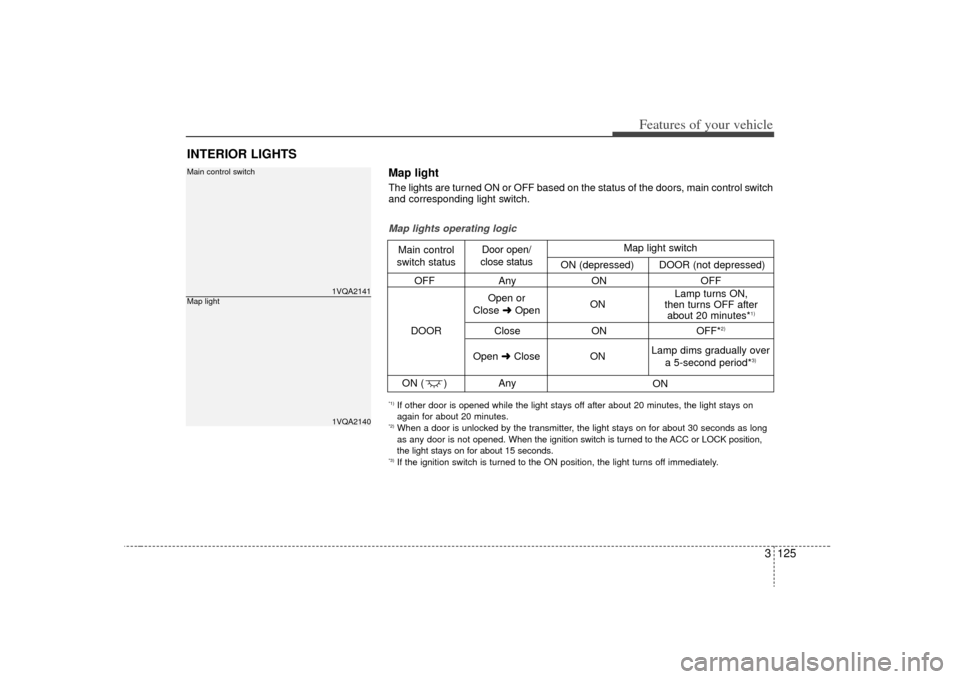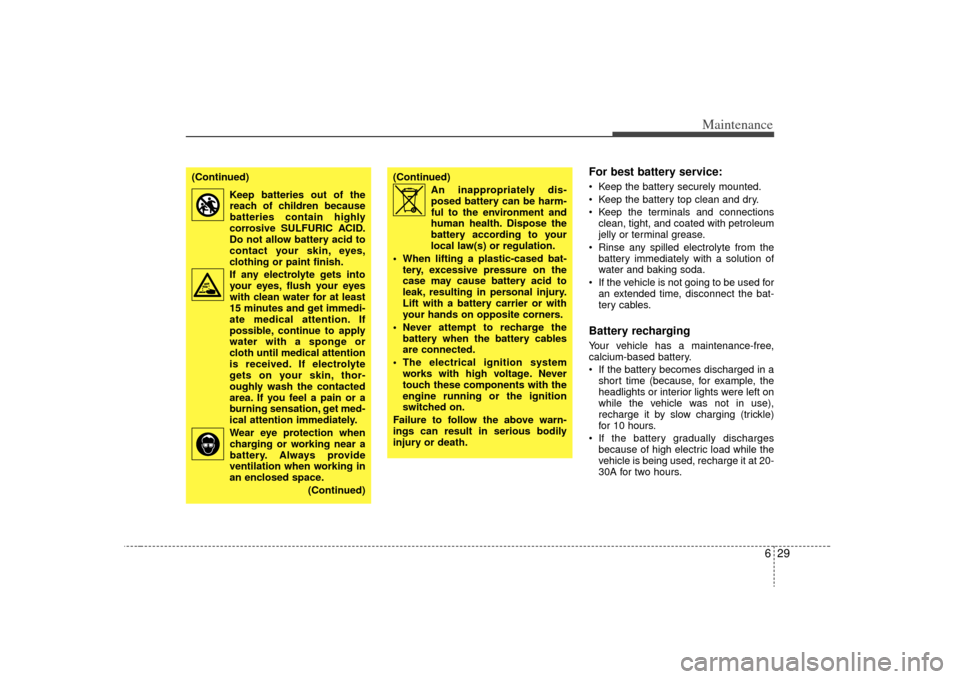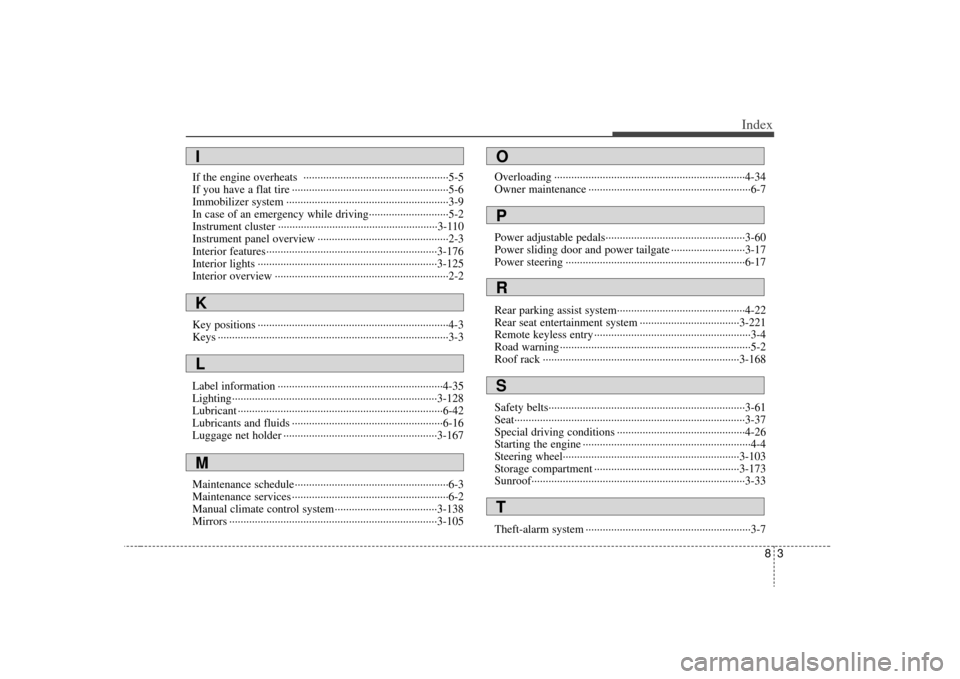2009 KIA Sedona interior lights
[x] Cancel search: interior lightsPage 11 of 356

Warnings and indicators / 3-120Interior lights / 3-125Lighting / 3-128
Wipers and washers / 3-132 Horn / 3-136
Defroster / 3-136
Hazard warning flasher / 3-137
Manual climate control system / 3-138
Automatic climate control system / 3-150
Windshield defrosting and defogging / 3-164 Luggage net holder / 3-167Roof rack / 3-168
Homelink® wireless control system / 3-169 Storage compartment / 3-173Interior features / 3-176 Antenna / 3-181
Audio remote control / 3-182 Audio system / 3-183
Rear seat entertainment system / 3-221
Features of your vehicle
3
Page 134 of 356

3 125
Features of your vehicle
INTERIOR LIGHTS
1VQA21411VQA2140
Main control switchMap light
OFFAny ON OFF
Close ON OFF*
2)
ON ( )Any
Map lights operating logicMain control
switch status Door open/
close status
DOOR Open or
Close \bOpen ON Lamp turns ON,
then turns OFF after about 20 minutes*
1)
Open \bClose
ON
ON
Lamp dims gradually over
a 5-second period*
3)
Map light switch
ON (depressed) DOOR (not depressed)
*1) If other door is opened while the light stays off after about 20 minutes, the light stays on
again for about 20 minutes.*2) When a door is unlocked by the transmitter, the light stays on for about 30 seconds as long
as any door is not opened.
When the ignition switch is turned to the ACC or LOCK position,
the light stays on for about 15 seconds.*3) If the ignition switch is turned to the ON position, the light turns off immediately.Map lightThe lights are turned ON or OFF based on the status of the doors, main control switch
and corresponding light switch.
Page 330 of 356

Maintenance28
6
OVQ066018N
Shunt connector Your vehicle is equipped with a shunt
connector to prevent battery discharge if
your vehicle is parked without being
operated for prolonged periods. Use the
following procedures before parking the
vehicle for prolonged periods.
1. Turn off the engine.
2. Turn off the headlights and tail lights.
3. Open the driver’s side panel cover and
pull up the shunt connector.
✽ ✽NOTICE• If the shunt connector is pulled up
from the fuse panel, the warning
chime, audio, clock and interior
lamps, etc., will not operate. Some
items must be reset after replacement.
(Refer to “Items to be reset···.” on
page 6-30)
• Even though the shunt connector is pulled up, the battery can still be dis-
charged by operation of the head-
lights or other electrical devices.
1VQA4005
Shunt connector
BATTERY
WARNING
- Battery
dangers
Always read the following
instructions carefully when
handling a battery.
Keep lighted cigarettes and all other flames or sparks
away from the battery.
Hydrogen, a highly com- bustible gas, is always
present in battery cells and
may explode if ignited.
(Continued)
Page 331 of 356

629
Maintenance
For best battery service: Keep the battery securely mounted.
Keep the battery top clean and dry.
Keep the terminals and connectionsclean, tight, and coated with petroleum
jelly or terminal grease.
Rinse any spilled electrolyte from the battery immediately with a solution of
water and baking soda.
If the vehicle is not going to be used for an extended time, disconnect the bat-
tery cables.Battery recharging Your vehicle has a maintenance-free,
calcium-based battery.
If the battery becomes discharged in ashort time (because, for example, the
headlights or interior lights were left on
while the vehicle was not in use),
recharge it by slow charging (trickle)
for 10 hours.
If the battery gradually discharges because of high electric load while the
vehicle is being used, recharge it at 20-
30A for two hours.
(Continued)
Keep batteries out of thereach of children because
batteries contain highly
corrosive SULFURIC ACID.
Do not allow battery acid to
contact your skin, eyes,
clothing or paint finish.
If any electrolyte gets into your eyes, flush your eyes
with clean water for at least
15 minutes and get immedi-
ate medical attention. If
possible, continue to apply
water with a sponge or
cloth until medical attention
is received. If electrolyte
gets on your skin, thor-
oughly wash the contacted
area. If you feel a pain or a
burning sensation, get med-
ical attention immediately.
Wear eye protection when charging or working near a
battery. Always provide
ventilation when working in
an enclosed space.
(Continued)
(Continued)An inappropriately dis-posed battery can be harm-
ful to the environment and
human health. Dispose the
battery according to your
local law(s) or regulation.
When lifting a plastic-cased bat- tery, excessive pressure on the
case may cause battery acid to
leak, resulting in personal injury.
Lift with a battery carrier or with
your hands on opposite corners.
Never attempt to recharge the battery when the battery cables
are connected.
The electrical ignition system works with high voltage. Never
touch these components with the
engine running or the ignition
switched on.
Failure to follow the above warn-
ings can result in serious bodily
injury or death.
Page 355 of 356

83
Index
If the engine overheats ··················\
··················\
···············5-5
If you have a flat tire ··················\
··················\
··················\
·5-6
Immobilizer system ··················\
··················\
··················\
···3-9
In case of an emergency while driving··················\
··········5-2
Instrument cluster ··················\
··················\
··················\
··3-110
Instrument panel overview ··················\
··················\
··········2-3
Interior features··················\
··················\
··················\
······3-176
Interior lights ··················\
··················\
··················\
·········3-125
Interior overview ··················\
··················\
··················\
·······2-2
Key positions ··················\
··················\
··················\
·············4-3
Keys ··················\
··················\
··················\
··················\
·········3-3
Label information ··················\
··················\
··················\
····4-35
Lighting··················\
··················\
··················\
··················\
3-128
Lubricant ··················\
··················\
··················\
··················\
6-42
Lubricants and fluids ··················\
··················\
·················6-16\
Luggage net holder ··················\
··················\
··················\
3-167
Maintenance schedule··················\
··················\
··················\
6-3
Maintenance services ··················\
··················\
··················\
·6-2
Manual climate control system··················\
··················\
3-138
Mirrors ··················\
··················\
··················\
··················\
·3-105Overloading ··················\
··················\
··················\
·············4-34
Owner maintenance ··················\
··················\
··················\
···6-7
Power adjustable pedals··················\
··················\
·············3-60
Power sliding door and power tailgate ··················\
········3-17
Power steering ··················\
··················\
··················\
·········6-17
Rear parking assist system··················\
··················\
·········4-22
Rear seat entertainment system ··················\
·················3-22\
1
Remote keyless entry ··················\
··················\
··················\
·3-4
Road warning ··················\
··················\
··················\
·············5-2
Roof rack ··················\
··················\
··················\
···············3-168
Safety belts··················\
··················\
··················\
···············3-61
Seat··················\
··················\
··················\
··················\
·········3-37
Special driving conditions ··················\
··················\
·········4-26
Starting the engine ··················\
··················\
··················\
·····4-4
Steering wheel···············\
··················\
··················\
···········3-103
Storage compartment ··················\
··················\
···············3-173
Sunroof··················\
··················\
··················\
··················\
···3-33
Theft-alarm system ··················\
··················\
··················\
····3-7IKLM
OPRST